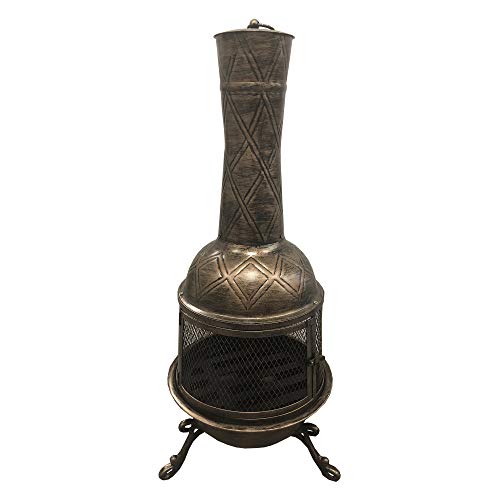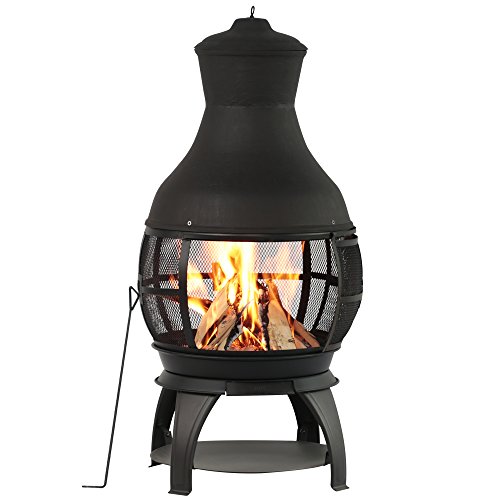10 Things That Your Family Taught You About Fire Pits Chimineas
페이지 정보

본문
 Fire Pits Vs Chimineas
Fire Pits Vs ChimineasChimineas are constructed with an enclosed structure that keeps sparks and embers in check effectively directing smoke upwards. This makes them safer to use in areas with children and on surfaces that are flammable.
Personal preferences for aesthetics are also a factor in the selection of clay and metallic models that are suited to a broad variety of garden and home styles.
Material
The type of material used in the chiminea could have an impact on the design and function. Models made of clay and terracotta come in many styles to complement both traditional and modern landscapes. Metal chimineas are more practical and designed to withstand extreme temperatures, so they can be used as cooking tools.
Both types of chimineas need some attention to ensure they are working at their peak. They should be cleaned regularly to avoid excessive accumulation of ash and protected from freezing and rain temperatures. They should be placed in a location free of flammable materials, and easily moveable. This is particularly important in the event that nearby plants are affected by fire or heat.
Chiminesas shouldn't be put out in the open, like a firepit. It should be set on a flat surface made for outdoor use such as pavers or cement. It should be placed at least 10 feet away from your home to avoid fire or fire pits chimineas smoke damage. Chimineas should be placed so that the predominant winds push smoke away from your house and towards the chimney stack. This will also eliminate unpleasant smells and soot.
It's important to note that a chiminea may produce more smoke than a fire pit, therefore it may not be ideal for large gatherings or parties where there are lots of people living in the immediate vicinity. Chimines are better at controlling smoke than a firepit as it's more confined and the chimney stack directs smoke upwards instead of outwards.
This wood-burning chiminea from Wiosi is a great option to get an chiminea that has a modern style. It has an opening with a triangular shape that allows you to add larger logs, and also provides 360-degree heat coverage. It also has a rain cap, a poker, and a grate for burning smaller pieces of wood.
Style
Both fire pits and chimineas can add value to your outdoor spaces by creating an inviting area to gather with friends and family on cold evenings. They differ in terms of design, style and purpose. Take into consideration space, aesthetic preferences, and safety concerns when deciding which type to buy. Think about your lifestyle and energy efficiency when choosing the best option.
A fire pit is an open bowl like a base on which you can stack logs and a chimney at the top to move smoke upwards. It is recommended to use kiln dried seasoned wood for the most effective performance. You should also have logs in your inventory so that you do not run out of wood before your guests depart. Chimineas are more traditional design and is designed to be used to cook as well as heating.
The word chiminea is derived from the Spanish word for chimney. They have broad bases that become a chimney. They are often adorned with intricate details that add a touch of class. They are ideal for Fire Pits chimineas small outdoor spaces, since they require very small space.
You can choose from a variety of options like steel and cast iron for strength and durability, as well as clay or terracotta for giving them a more traditional look. A fireplace made of clay or terracotta may crack when heated up. But, it's the least costly option. It also has a charming vintage look that can boost your home's value. Cast iron is more durable and heavy than other metals. However, it can be more expensive.
Some chimineas feature a metal finish that has a natural rust patina. This is a result that happens when metal is exposed air and water. This finish is long-lasting, and lasts for a long time. It is essential to maintain your chiminea by cleaning it regularly with the use of a brush and soapy water. To avoid corrosion and rust it is crucial to protect your chiminea from direct contact with water after heating. You should also be careful to move your chiminea with care and not place it on surfaces that may be damaged by the intense heat.
Ventilation
The design of a chiminea includes an elongated chimney that funnels smoke and soot away from those that are gathered near the fireplace. It can be used even in small spaces. It also provides an optimal air circulation that is perfect for outdoor cooking. This lowers the chance of fire-related damage to your furniture and patio.
Chimineas can be made out of terracotta chiminea or clay or from a variety of metals like cast iron and steel. The former is less sturdy and can crack when exposed to high temperatures or rough handling, while the latter is more durable and available in a variety of attractive designs that can add a rustic look to your patio.
Chimineas and fire pits, offer warmth and an atmosphere for your backyard. They are also simple to maintain. If you take the necessary precautions, a chiminea or fire pit will last for many years to be.
Chimineas are a great way to add a touch of elegance to your patio or garden. Their broad base is able to be tapped into narrow chimney. They are a great choice for small chiminea outdoor areas where a fireplace may not fit or could restrict access to other seating options. Make sure you keep a indoor chiminea no more than 10 feet from the house, and place it where the predominant wind pattern can take smoke away from your home.
Chimineas can burn a variety of woods including aromatic varieties like cedar and hickory. You can also position it to enjoy the fire from one side while making sure it is hidden from neighbors.
Some might claim that the popularity and usage of fire pits has made the chiminea obsolete, but it's important to take into account your own needs when choosing between them. Each kind of fire feature has distinct advantages. The bowl-shaped open design of a fire pit allows you to build larger logs and radiate heat in a 360-degree circular pattern, while chimineas have a more enclosed base that focuses the heat downwards. While both are excellent options for bringing a sense ambience to your backyard The best option will depend on what you'll use it for.
Heat distribution
Chimineas are enclosed to improve heat distribution. This reduces the use of resources and environmental impact, particularly when compared to fire pits chimineas (Suggested Site) pits. However, both types produce smoke that is made up of particles of matter as well as other harmful chemicals that can degrade air quality and aggravate respiratory ailments. Several factors influence the amount of smoke that is produced, including the type and moisture content of the wood, the weather conditions, as well as the length of time the fire burns. To minimise this effect make sure to use dry, seasoned wood and chimineas with effective designs.
Chimineas, in contrast to fire pits and fireplaces, have a chimney that focuses smoke upwards. This helps keep the flames from people and other objects that are flammable and reduces the amount of smoke and soot. They're ideal for outdoor seating areas where guests can relax close to each other. Furthermore their curved walls and wide access makes it easier to tend to the fire without disrupting conversation or creating smoke inhalation.
They're also more sturdy than fire pits which can move with the wind and pose more dangers to safety due to their open flames as well as the shifting smoke direction. They don't have as much direct heat to cook as fire pits, since they can only support small briquettes and logs.
Both chimineas and fire pits require a preliminary setup before you can use them. Chimines require more preparation, such as pebbles or sand at the base before it is used. A fire pit does not require this preparation. It is enough to add fuel and ignite the fire.
In addition to regular cleaning, both chimineas and fire pits need to be set on a grate or a bed of sand to keep them from causing damage to your patio floor. Some chimineas weigh as much as 200 pounds and are difficult to move once installed. You'll also have to spray your chiminea frequently with high-temperature paint to prevent corrosion and preserve its original appearance. A fire pit is able to be moved easily, making it more flexible for different locations.

- 이전글5 Killer Quora Answers To Mini Cooper Key 25.02.01
- 다음글القانون في الطب - الكتاب الثالث - الجزء الثاني 25.02.01
댓글목록
등록된 댓글이 없습니다.
